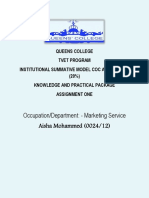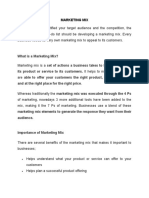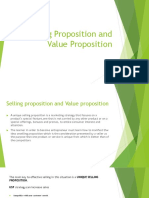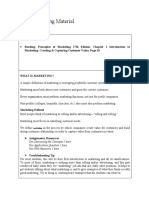10 Minute Guide Marketing Mix
10 Minute Guide Marketing Mix
Uploaded by
wimarherdantoCopyright:
Available Formats
10 Minute Guide Marketing Mix
10 Minute Guide Marketing Mix
Uploaded by
wimarherdantoCopyright
Available Formats
Share this document
Did you find this document useful?
Is this content inappropriate?
Copyright:
Available Formats
10 Minute Guide Marketing Mix
10 Minute Guide Marketing Mix
Uploaded by
wimarherdantoCopyright:
Available Formats
10 Minute Guide
Marketing Mix
What it is
The Marketing Mix is a term used to describe the combination of tactics used by a business to achieve its objectives by marketing its products or services effectively to a particular target customer group. It is also referred to as the 4 Ps Product, Price, Promotion and Place, or the 7 Ps the 4 Ps with the addition of People, Process and Physical Evidence.
What you should do
Make sure you have identified each of your target customer groups. If you have not already done so and would like further information on grouping your customers, take a look at our 10minute Target Customer briefing. Now, with each customer group in mind, work through the steps outlined below.
Why it is important
Businesses need to make sure they are marketing The right product to The right person at The right price in The right place and at The right time For example, if you manufacture pens, and have decided to target schoolchildren, it would be more appropriate to market Coloured ballpoint pens (product) At a low price (price) Selling them through newsagents and stationers (place) And promoting them through point of sale material (promotion) than it would be to market Gold fountain pens (product) At a high price, including insurance against loss (price) Selling them through specialist outlets and jewellery stores (place) And promoting them in glossy magazines and Sunday Supplements (promotion)
Product
Marketing is about identifying, anticipating and satisfying customer needs. You need to be sure that your products and services continue to meet your customers needs. 1. Carry out simple research by asking your customers What they think of each product/service How satisfied are they with the quality How satisfied are they with any support services you may provide How effective it is in meeting their needs How they see their needs changing in the short and long term future 2. Carry out step 1 for each product or service you offer 3. Have a system for collecting and analysing feedback from your customers so that ideas are fed into a new product development process that is ongoing.
www.cim.co.uk The Chartered Institute of Marketing 2004
10 Minute Guide: Marketing Mix 4. Ask yourself what stage of the product life cycle your products or services have reached. The product life cycle is one way of looking at how the marketing mix links together. Products are said to go through stages an introductory stage, a growth stage, a mature stage and a decline stage. At each stage a slightly different mix is appropriate see the What you need to know section of this material for more information. 5. Analyse the profitability of each product/service you offer. For more information on calculating this, take a look at the 10-minute 80/20 Rule. Which products/services make the biggest contribution or provide the highest profitability? What support services do you offer with each product? Could it be improved, adding value with little cost? 3. If you are selling to businesses you will have to cover the cost of a sales force. This can be an expensive overhead and will again impact on your pricing.
Price
Place
Place is the means of distribution you select depending on the type of product or service you are marketing. Your choice will impact on your pricing and your promotion decisions. 1. Are the customers for your products and services consumers or businesses? If they are consumers you will have three main options Selling to wholesalers who will sell to retail outlets who will sell on to the consumer Selling direct to retail outlets Selling direct to the customer If your customers are businesses you will probably sell to them direct through your own sales force. 2. If you sell through wholesalers and retailers, remember when you price your products that they will each want their own mark-up to cover their overheads. You will also need to promote your products and services to all members of the channel. Wholesalers and retailers will have to be persuaded to stock your product and end customers to buy them.
Price generates profit so is an important element of the mix. You need to consider 1. What your target group of customers will be prepared to pay for your product or service. It is important not to set the price too low as customers may think there is something wrong with the product. Equally, if you set the price too high, customers may think that it is too expensive for the benefits offered. Think about how you have positioned your product in terms of quality. This will help you to assess how to price it. 1. What it costs you to produce it. This will show you what you need to charge and not what you could or should charge. However, if you do not calculate what it costs you to produce your product correctly, the more you sell, the more you will lose. Dont forget to make an allocation for costs such as selling which are usually treated as fixed. (See item 1 for more information.) 3. What your competitors charge. Look at your competitors web sites, or simply phone them and ask for a price list or quotation.
Promotion
The promotional mix is made up of 5 elements: advertising sales promotion public relations direct marketing personal selling
www.cim.co.uk The Chartered Institute of Marketing 2004
10 Minute Guide: Marketing Mix The combination of tools you use depends on the budget you make available, the message you wish to communicate and the group of customers you are targeting. To find out more about developing a promotional mix as part of your wider marketing mix, take a look at the 10-minute Promotional Mix. 1. Look at all the processes involved in getting your products to the customer. Start with the identification of prospects and work through to after-sales support. Does any stage cause a delay? How can you improve this? 2. Are your customers kept informed about what is happening? 3. Do your staff keep their promises to customers? 4. How effectively are you handling customer complaints?
People
The people employed in your organisation will determine the quality of service your customers receive. This is truer for services, but also impacts on businesses making tangible products. Happy, skilled and motivated staff make happy customers. They are more likely to think about the customer and deliver good customer service if they are well trained and are recruited for their positive attitude to customers. You can achieve a competitive advantage over your competitors through offering a high level of pre-sales and after-sales support and advice. Again, this can impact on the price you set, as customers are likely to be prepared to pay more for the service they receive but there may be a higher cost for you to take into account. Identify those staff who come into contact with customers, either face-toface or by phone. 1. Carry out a task analysis of what they do in terms of customer contact. 2. Involve your staff in setting standards for customer service. For more information on customer service, look at the 10-minute Customer Service Programme. 3. Prioritise training needs for these staff and provide appropriate training
Physical Evidence
Physical evidence is a term used to describe the type of image that your business portrays through its physical presence, namely its premises, the appearance of its staff, its vehicles, etc. When customers do not have anything that they can touch, see or try before they buy, they are more likely to assess you by the image you put across. It is therefore particularly important if you offer services rather than tangible products. 1. How tangible is the product you market? If it is heavily dependent on the service element (for example, a restaurant, or hotel, or window cleaning service, or hairdressing) then you should pay particular attention to this element of the mix. Even if you are a manufacturer, this element is important if customers visit your premises. 2. Ensure that the image portrayed by your organisation is consistent with the type of product or service you offer. 3. Look at your reception area, your car park (are there spaces for visitors near to the entrance), the appearance of your delivery staff or customer service staff, that condition of your vehicles, etc. Where can you make improvements?
Process
The processes involved in delivering your products and services to the customer have an impact on the way in which your customers perceive you.
www.cim.co.uk The Chartered Institute of Marketing 2004
10 Minute Guide: Marketing Mix
What to do now
If you have not already done so, you need to think about your promotional mix. For more information on this, see our 10-minute briefing on the Promotional Mix. You should also plan a customer service programme. You can see what is involved by looking at the 10-minute Customer Service Programme.
Where to find out more
For more on the marketing mix, try looking at http://www.brunel.ac.uk - A Business Open Learning Archive with a summary of the marketing mix. http://www.marketingteacher.com/Less onstore.htm - Key topics from many marketing courses designed for marketing learners and free from Lessonstore. http://www.businessbureauuk.co.uk/growing_business/sales_and_ marketing/marketing_mix.htm - Tips on establishing the right product, price, place and promotion for your business.
What you need to know
If you want to take forward some of the ideas described here, below are some keywords (shown in italics) that you can use to search for further information on this website or in various marketing texts. Product about the product life cycle and product portfolio analysis Price about different approaches to pricing that are market based, and about marginal costing. Promotion about the advantages and disadvantages of the various promotional tools, about customer behaviour, and about budget setting techniques. Place about appropriate channels to market for your products and services People, Process & Physical Evidence about customer service and effective processes and environments for the delivery of your products and services.
www.cim.co.uk The Chartered Institute of Marketing 2004
10 Minute Guide: Marketing Mix
An example in practice
Look at the e-marketing case Greenfingers.com on www.cim.co.uk . This case shows that Greenfingers.com has clearly defined its target audience through marketing research. Product Its product is garden equipment and plants. However, the company has differentiated itself from its competitors through its website and the provision of extensive information. It offers enhanced service through an effective search facility and advice on planting. Place The company deals direct with the customer, outsourcing only its deliveries. It has indicated that it may consider bricks and mortar outlets in the future. Price The case does not give details of pricing policies, which will have to cover the costs of delivery and contribute to overheads with the aim of moving the business into profit. Promotion The company has integrated on-line and off-line promotion. Promotion includes on-line affiliations (providing content for several portals), a mail-order catalogue in selected consumer magazines, direct mailing, and interactive TV. People The case highlights the fact that the management team were recruited for the combination of experience in marketing, gardening and on-line that they bring to the business. They have selected Securicor to undertake their deliveries.
Process The case emphasises that the company sees it important to err on the side of caution, offering a level of service it knows it can deliver, so that customers are not disappointed. It carries out e-mail surveys after deliveries are made, ensuring that customer expectations continue to be met. Physical Evidence Securicor is the face of Greenfingers.com at the moment. The image they put across must give the same credibility as Greenfingers.com provides itself. Greenfingers already checks on this through its e-mail surveys. At this point it will be important that the image is consistent with the rest of its mix.
The Chartered Institute of Marketing will work with you to identify and develop your training needs. Web: www.cimtraining.com
Please contact our Training Advisory Team on: Email: training@cim.co.uk Phone: +44 (0) 1628 427 200 for all your training enquiries.
www.cim.co.uk The Chartered Institute of Marketing 2004
You might also like
- Details of Marking MixDocument8 pagesDetails of Marking MixHrishikesh KharadeNo ratings yet
- How To Achieve An Effective Promotion MixDocument9 pagesHow To Achieve An Effective Promotion MixJayaprakash KanagarajNo ratings yet
- How To Achieve An Effective Promotional Mix: 10 Minute GuideDocument9 pagesHow To Achieve An Effective Promotional Mix: 10 Minute Guidedong hyukNo ratings yet
- IGNOU MBA MS-06 Solved Assignments 2012Document47 pagesIGNOU MBA MS-06 Solved Assignments 2012MMMMr123No ratings yet
- The Way To Ans The Question ???: Price MixDocument5 pagesThe Way To Ans The Question ???: Price MixNkit MogheNo ratings yet
- SDM NoteDocument5 pagesSDM NotesamNo ratings yet
- Entrep2 Q L1-7Ps Marketing MixDocument4 pagesEntrep2 Q L1-7Ps Marketing MixMetzger ChumalanNo ratings yet
- Tutorial 1: An Overview of Contemporary Marketing SECTION A: Discussion QuestionsDocument5 pagesTutorial 1: An Overview of Contemporary Marketing SECTION A: Discussion QuestionsP'NG RUI XUANNo ratings yet
- Marketing Mix DefinitionDocument14 pagesMarketing Mix DefinitionAnonymous ckTjn7RCq8100% (1)
- Entrep (11-20)Document49 pagesEntrep (11-20)Maricel BumanglagNo ratings yet
- IGNOU MS 06 SolutionDocument21 pagesIGNOU MS 06 SolutionnavinNo ratings yet
- Marketing and Sales FaqDocument7 pagesMarketing and Sales FaqasharNo ratings yet
- Marketing Principles and StrategiesDocument8 pagesMarketing Principles and StrategiesSedric MarinayNo ratings yet
- Occupation/Department: - Marketing Service: Aisha Mohammed (0024/12)Document4 pagesOccupation/Department: - Marketing Service: Aisha Mohammed (0024/12)feruza musemaNo ratings yet
- Assignment 1Document4 pagesAssignment 1PricilliaNo ratings yet
- The Marketing Mix: Entrepreneurship Myra F. de LeonDocument21 pagesThe Marketing Mix: Entrepreneurship Myra F. de LeonguiaNo ratings yet
- The 7 Ps of MarketingDocument7 pagesThe 7 Ps of MarketingGunjan SainiNo ratings yet
- Marketing and The 7psDocument10 pagesMarketing and The 7pskartuteNo ratings yet
- Chapter Five Marketing and New Venture Development 5.1 The Marketing PerspectiveDocument8 pagesChapter Five Marketing and New Venture Development 5.1 The Marketing Perspectivehussien amareNo ratings yet
- Manage Quality Customer ServiceDocument44 pagesManage Quality Customer ServicenehaNo ratings yet
- The 15 Most Common Types of Customer Needs (And How To Solve For Them)Document7 pagesThe 15 Most Common Types of Customer Needs (And How To Solve For Them)John evansNo ratings yet
- Manage Quality Customer ServiceDocument49 pagesManage Quality Customer ServiceMissy Pumpuy75% (4)
- The Marketing Mix and 4 PS: Understanding How To Position Your Market OfferingDocument8 pagesThe Marketing Mix and 4 PS: Understanding How To Position Your Market OfferingSabhaya ChiragNo ratings yet
- What Is A Marketing MixDocument10 pagesWhat Is A Marketing MixMariven NavarroNo ratings yet
- Allama Iqbal Open University Islamabad (Department of Business Administration)Document13 pagesAllama Iqbal Open University Islamabad (Department of Business Administration)mani_hashmiNo ratings yet
- CH 05 Marketing and New Venture DevtDocument10 pagesCH 05 Marketing and New Venture DevtWondmageneUrgessaNo ratings yet
- Q1-Lesson 1.2 - Define and Understand MarketingDocument20 pagesQ1-Lesson 1.2 - Define and Understand MarketingJERRALYN ALVANo ratings yet
- Basic Principles of MarketingDocument11 pagesBasic Principles of Marketingbhavin gauswamiNo ratings yet
- Principles of Marketing Chapter 1Document61 pagesPrinciples of Marketing Chapter 1jhoana marie oronanNo ratings yet
- Chapter-1 Definition of Marketing For 21st CenturyDocument12 pagesChapter-1 Definition of Marketing For 21st CenturyTrifling TechNo ratings yet
- 01 Coordinate Sales PerformanceDocument7 pages01 Coordinate Sales PerformanceSAMUALE ASSEFA MEKURIYA100% (1)
- Service Marketing MBA Project ReportDocument7 pagesService Marketing MBA Project ReportAhamed IbrahimNo ratings yet
- Marketing ReviewerDocument14 pagesMarketing ReviewerJade ivan parrochaNo ratings yet
- Bulletproof Marketing Plan. Only 1-Page Plan = Profit Growth At 300% Or MoreFrom EverandBulletproof Marketing Plan. Only 1-Page Plan = Profit Growth At 300% Or MoreNo ratings yet
- Chapter 2 Customer RelationshipDocument36 pagesChapter 2 Customer Relationshipdeniseannecabungason9No ratings yet
- Vinay Ch1ansDocument4 pagesVinay Ch1ansMukeshKumawatNo ratings yet
- Marketing MixDocument10 pagesMarketing MixVijay KumarNo ratings yet
- Selling Proposition and Value PropositionDocument11 pagesSelling Proposition and Value PropositionAldrin BocoNo ratings yet
- Marketing and Communications Strategies: The GuidesDocument11 pagesMarketing and Communications Strategies: The GuidesMirza Arsalan BaigNo ratings yet
- 7 Ps of Marketing - Me The ObserverDocument1 page7 Ps of Marketing - Me The Observergt467pxsnkNo ratings yet
- LO1 MarketingDocument6 pagesLO1 MarketingBashar AlfyNo ratings yet
- Personal Selling - Personal Presentation by The Firm's Sales ForceDocument5 pagesPersonal Selling - Personal Presentation by The Firm's Sales ForceShweta KumariNo ratings yet
- Final AssessmentDocument10 pagesFinal AssessmentSajanth LucksmanNo ratings yet
- Unit 5 The Art of Personal Selling: Show and TellDocument4 pagesUnit 5 The Art of Personal Selling: Show and TelluzziNo ratings yet
- Marketing MixDocument6 pagesMarketing MixBrian MulengaNo ratings yet
- MarketingDocument46 pagesMarketingAakash SolankiNo ratings yet
- Assignment Beauty TherapyDocument19 pagesAssignment Beauty TherapyglamsaestheticmataramNo ratings yet
- 4P's of Marketing: Consumer. It Also Identifies Target Markets As Well As Applies Services andDocument3 pages4P's of Marketing: Consumer. It Also Identifies Target Markets As Well As Applies Services andDianne Permejo del PradoNo ratings yet
- Adi AssignmentDocument13 pagesAdi AssignmentShraddha KhuranaNo ratings yet
- Question No.1: How Automation Can Improve CRM?Document5 pagesQuestion No.1: How Automation Can Improve CRM?Rana AhmadNo ratings yet
- Bangladesh University of Business Technology (BUBT) : AssignmentDocument11 pagesBangladesh University of Business Technology (BUBT) : AssignmentSourab chowdhuryNo ratings yet
- Service MarketingDocument8 pagesService MarketingrajehsNo ratings yet
- Marketing Mix 4P'sDocument33 pagesMarketing Mix 4P'sPankaj singhNo ratings yet
- Subrata Manna 3Document8 pagesSubrata Manna 3subhajitdhulya38No ratings yet
- Chapter FiveDocument7 pagesChapter FivemuluNo ratings yet
- Company Orientation Towards Market PlaceDocument5 pagesCompany Orientation Towards Market PlaceRasel Raz100% (1)
- Week 1 Learning Material: Key ConceptsDocument8 pagesWeek 1 Learning Material: Key Conceptshajra ubaidNo ratings yet
- 3.concepts of Marketing MixDocument3 pages3.concepts of Marketing MixEfti Khairul AlamNo ratings yet
- Service MarketingDocument47 pagesService MarketingAtaye Waris KhanNo ratings yet



























































